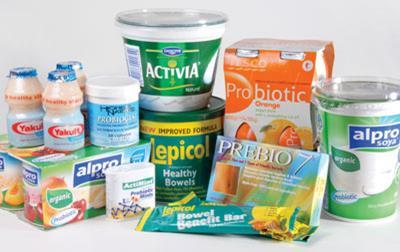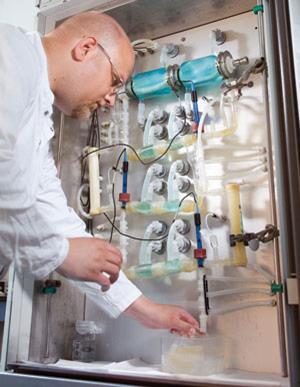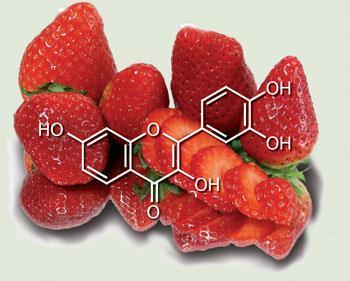Could the foods we eat be engineered to stave off disease, keeping us fit and healthy far into old age? Ned Stafford looks into the growing trend for functional food
Could the foods we eat be engineered to stave off disease, keeping us fit and healthy far into old age? Ned Stafford looks into the growing trend for functional food
One body per life. That’s it - no trade-in for a newer model allowed. The body we are born with is the same one we will have to use right into old age.
While many peoples’ bodies remain relatively fit until they die, other bodies don’t age so gracefully and their owners fall prey to cancer, cardiovascular problems, Alzheimer’s disease and other ailments. But why do some bodies function properly throughout life while others begin to gasp and creak like rusty old autos?
Medical doctors and pharmaceutical companies have tended to focus on using drugs to treat diagnosed diseases. But many scientists are coming to believe that food is the answer, and that the risk of many diseases might be significantly reduced with foods and drinks containing the right compound combinations. Put simply, this means higher amounts of the beneficial substances than found in traditional diets, and lower amounts of the bad stuff. They also believe that, in some cases, altered foods might benefit people already suffering from diseases.
Harry McArdle, deputy director of science at the Rowett Institute of Nutrition and Health at the University of Aberdeen, UK, says that scientists around the world, including many at major global food companies such as Nestl? and Danone, are now trying to unlock the secrets of compounds in food and how those compounds are used by the human body. Noting that food compounds have developed over a long period in evolutionary time and that the human body is a very complicated piece of hardware, he admits this is not a simple task. ’It is quite clear that there is an enormous amount we don’t know,’ he says.

For example, scientists still do not have a firm grasp of all the potential active ingredients in food, he says. Further complicating the issue, many food compounds are broken down into new compounds once inside the body, some in the stomach and others further down the digestive tract. When compounds are identified, scientists need to figure out how they are metabolised, where they end up in the body and what effect they have. And they need to learn how various compounds interact. As a case in point, McArdle notes that zinc is necessary for proper human growth, but that zinc absorption can be inhibited by phytic acid, a natural metal chelator found in ’healthy’ foods such as bran, wholegrain cereals, pulses and nuts.
However, this complex picture hasn’t discouraged a few pioneering firms from trying to develop new kinds of functional foods - even including those aimed at heading off cancer or improving brain function.
Foods of the future
The concept of altering foods to make what we eat healthier is not new. Supermarkets have for decades been selling bread enriched with vitamins and minerals, milk with added vitamin D, and salt with iodine. Some altered food products date to the early 20th century, according to Mirjam Govers, director of research communications at global food giant Danone’s Research Centre for Specialised Nutrition in Wageningen, the Netherlands. For example, the Dutch firm Nutricia in 1905 produced a sterilised low sugar milk product, developed for diabetics, which Govers describes as ’pioneering the concept of specialised medical nutrition’.

In recent years, with older members of the baby-boomer generation on the verge of becoming senior citizens, global food makers see potential for big profits in selling them foods designed to keep them healthy as they age. Already the market is being flooded with new products. One of the best known, and a huge revenue source for Danone and other large and small companies, are probiotics, dietary supplements of live microorganisms often based in yoghurt or yoghurt-type drinks to improve digestion or confer other health benefits.
Exactly what these new healthy foods are called is open to debate - and reflects the variety of different sub-categories, which range from today’s functional foods to the medicinal foods and nutraceuticals still under development in the lab.
The biggest of those groups is functional foods, so-called because of added functional ingredients that focus on a certain bodily function or organ. Functional foods include such products as probiotic yoghurts for the digestive tract or orange juice with added calcium for bones.
Patrick Rea, publisher of the Nutrition Business Journal based in healthy food hotspot Boulder, Colorado, US, says he defines functional foods simply as ’foods with added nutritional ingredients.’ Rea believes that even sports hydration drinks such as PepsiCo’s Gatorade are functional foods.
Under such a broad definition, many of the foods now on the market have health benefits. Nonetheless, they could be considered primitive compared to the food products that await us on supermarket shelves in the years ahead. For example, Danone Research in July 2008 announced completion of a first clinical trial for Souvenaid, a multi-nutrient drink designed to improve cognitive function in patients with the early signs of Alzheimer’s. Danone says the drink is ’the result of ten years of research and development into the potential role of nutrients in neurological diseases’, and that the clinical trial successfully demonstrated proof of concept.
Govers declined to provide fresh details on Souvenaid, saying more studies are needed. ’We are not thinking of market yet,’ she says. Govers also declined to talk about the company’s HIV-related food research, saying that the work is still at the pre-clinical stage.

While such ideas may sound like science fiction, there are strong molecular rationales behind the idea - often, like drug molecules, inspired by nature. Sheldon Hendler, a clinical professor at the University of California, San Diego, US, and co-editor-in-chief of the Journal of Medicinal Food, says scientists are already working on synthetic forms of some naturally occurring food compounds - including fisetin, a flavonoid found in strawberries that shows promise for cognition.
However, he says any cognitive benefit would require eating about 5kg of strawberries a day. ’But if one can synthesise a molecule that has the exact structure of a molecule found in foods, then the activities will be identical,’ he says. Researchers are already exploring synthetic forms of fisetin, as well as analogues of the compound, Hendler adds. And companies like Danone and Nestl? are already adept at squeezing large numbers of nutrients into medicinal foods.
Medical nutrition
One sub-category of medical food already on the market is medical nutrition. Govers described medical nutrition as managing disease-related malnutrition or symptoms. ’Basically, medical nutrition is a type of category between food and the pharmaceutical business,’ she says.

Danone dived headfirst into the emerging medical nutrition market in 2007 by paying €12.3 billion (?11.1 billion) for the Dutch firm Royal Numico, which included Nutricia, SHS International in the UK, and other nutritional food brands.
As an example, Govers mentions Fortisip Compact, a high nutrition drink in a 125ml bottle for people with little appetite or unable to consume normal amounts of food. Fortisip Compact contains all the nutritional value of an earlier Fortisip product marketed in 200ml bottles, which are too large for some patients in hospitals and nursing homes to consume.
Medical nutrition products can take up to 10 years to develop, says Govers. ’Composition of medical nutrition is very specific and cannot be replaced by normal food,’ she says. ’You would need trays of food to replace a single bottle of medical nutrition.’
Much like Danone, Nestl? Healthcare’s products include those aimed at patients recovering from surgery or who otherwise might have reduced appetites. For example, Nestl? Nutrition markets Clinutren fruit- and milk-based drinks, soups and desserts that are proportionally high in calories and other nutrients to help cancer patients gain weight or prevent weight loss.
Body chemistry
The 200 scientists at Danone’s research centre represent most life sciences fields, with chemists playing a large role. ’Biochemistry is basically the heart of all processes in the body,’ Govers says.
Hendler adds that chemists worldwide are playing a leading role in the quest for life-long health. He calls the broad field ’integrative biochemistry’.
’What I call integrative biochemistry is a way of thinking that brings together the elements of biochemistry with the substances found in foods to help understand how these substances, or variations of these substances, may play roles in human health,’ says Hendler.

’For example,’ he adds, ’vitamins and minerals for the most part are cofactors in biochemical reactions. Amino acids and nucleotides are precursors in the formation of informational and structural molecules. Some types of carbohydrate molecules are involved in cell signalling and communication. These are all processes that underlie the functioning of the body and when they go awry, can lead to disease. Integrative biochemistry is the integration of our understanding of these molecules and processes in order to optimise the conditions that lead to good health and longevity.’
Large numbers of scientists at Nestl? are also working on the problem. The hub of activity is the Nestl? Research Centre in Lausanne, Switzerland, home to 700 staff, of which 300 are scientists. The centre has eight divisions, including food science, nutrition and health and bioanalytical science, which seeks to understand how food molecules affect bodily processes. Nestl? scientists collaborate with external institutes and universities around the world. In 2008 Nestl? invested SF1.98 billion (?1.2 billion) in its 26 research, development and technology centres around the world.
Hilary Green, head of R&D communications at Nestl?, says that traditional Nestl? food products, such as breakfast cereals, soups or frozen foods, are basically targeted toward ’people who are healthy and want to stay healthy or be healthier’. But Nestl? Nutrition is for more focused markets and is divided into four main areas: infant nutrition, sports nutrition, healthcare and weight management. The healthcare unit focuses on five areas: Crohn’s disease, cancer, gastrointestinal compromised ailments, diabetes, and the elderly.
And like Danone, Nestl? is also actively exploring the possibility of producing foods that one day might reduce the risk of cancer or Alzheimer’s. In late 2006, Nestl? signed a five year agreement with the Federal Polytechnic School (EPFL) in Lausanne, to cooperate on research into the role of nutrition in cognitive function, including brain development in children and brain decline in older age.
Nestl? also signalled interest in the link between food and cancer by making it the topic of the Fourth Annual Nestl? International Nutrition Symposium (NINS) in October 2007. ’We know that some food increases the rate of cancer, so it is reasonable to assume that the link could also be the other way around,’ Green explains.
But Green emphasises that Nestl? is not selling food as medical treatments. While Danone’s Gover freely used the term ’medical nutrition’ for her company’s products, Nestl? does not use the word medical to describe its wares. Instead, the Nestl? Nutrition website says the company is ’developing and delivering innovative, effective, scientifically proven nutrition products with functional benefits.’ ’We want to send a clear signal that we are not doing medicine,’ she says. ’We are not trying to find a magic bullet for a condition.’
She declined to reveal more about forward-looking Nestl? research, saying: ’If we give this away we give too much to our competitors.’ Discretion is understandable in a market
that although still in a primitive stage is already generating huge sales in the billions around the world.
For a market segment that is still considered young, these numbers are impressive. For example, Nestl? Nutrition, the division that now includes Novartis Medical Nutrition, posted global sales of SF10.4 billion in 2008, which accounted for nearly 10 per cent of Nestl?’s total sales of SF110 billion.
Green acknowledges that the company sees Nestl? Nutrition as a major business in coming years. ’It is a very important business and a lot of the research and development we do at Nestl? is for this business,’ she says.
Reluctance to talk about upcoming developments is not restricted to the commercial sector. Alan Rowe, the Rowett Research Services CEO, says that the Rowett Institute regularly collaborates with scientists from food companies, either by conducting contract research for the companies or in joint projects. ’We are talking about major global players,’ he says. And who might these global players be? That is secret, Rowe says, adding: ’You are not going to push me on that.’
Rea says the big food companies are moving quickly to capture slices of the fast growing functional food market. In 2007, functional foods accounted for six per cent of the total US food industry, and the sector is growing three times as fast as the total food industry. ’The food companies see functional foods as a way to steal share from their competitors in a slow-growth, low-margin food industry,’ he says.
Big farmer?
On the surface, the medical foods sector would look just as appealing to pharmaceutical companies as to food firms - and a few years ago, several pharmaceutical companies were dipping their toes into the medical nutrition market. It seemed like a natural fit, especially considering how experts like Hendler describe the effect of food on molecules in the human bodyalmost in the same way a pharmacologist might describe the effect of drugs on the body.

But in most cases, pharma firms were not pleased with food results and jettisoned their medical nutrition units. One example was Novartis Medical Nutrition, which Nestl? bought in 2007 for $2.5 billion (?1.7 billion). The deal came with 2000 Novartis employees, including scientists.
Rowe, who as Rowett Research Services CEO deals regularly with corporate collaborators of the Rowett Institute, says that he believes pharma firms tested the field hoping for pharmaceutical-scale profit margins. ’I don’t think they understood the dynamics of the food sector as well as they thought they did,’ he says, adding that the pharma firms also lack know-how of food manufacturing and distribution.
However, there are exceptions to the trend, one being Chicago, US-based pharmaceutical
company Abbott Laboratories, which continues to market a wide range of nutritional products, from infant milk formula to foods designed for patients with specific conditions, including diabetes and kidney disease.
Eat for victory
As for the future of ’health-enhanced’ foods, McArdle sees comparisons with early penicillin research. After penicillin was discovered in 1928, it became a base that snowballed into a lot of other discoveries. Referring to current food research, McArdle says: ’I think this is the kind of thing that is going to happen’.
’The origin of the statins, for example, was from food-based molecules,’ adds Hendler. ’I personally believe that developing drugs from foods is the way of the future.’
Comparing the task ahead for scientists to mountain climbers, McArdle says: ’We are still at the bottom of a very large mountain.’ And if scientists succeed in reaching the top? ’If we get it all right, then we can live forever,’ McArdle chuckles. Then seriously, he adds: ’I think the idea is you want to be healthy until you die.’
In other words, food scientists are seeking a sort of quasi ’fountain of youth’. Maybe not food that will ensure immortality, but the next best thing: a well functioning human
body right through to old age.
Ned Stafford is a freelence science writer based in Hamburg, Germany






No comments yet